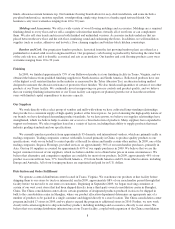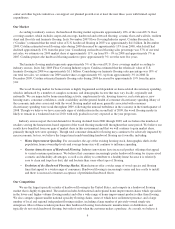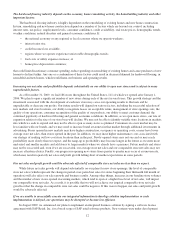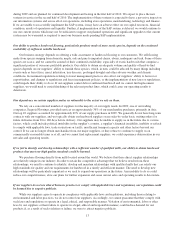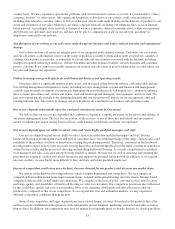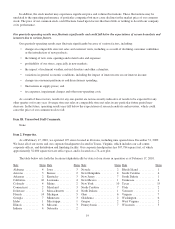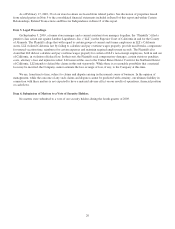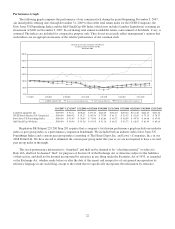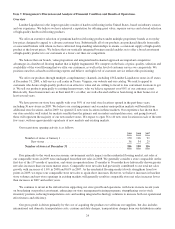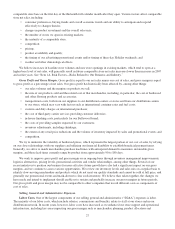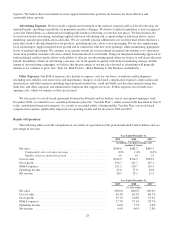Lumber Liquidators 2009 Annual Report Download - page 24
Download and view the complete annual report
Please find page 24 of the 2009 Lumber Liquidators annual report below. You can navigate through the pages in the report by either clicking on the pages listed below, or by using the keyword search tool below to find specific information within the annual report.For policies under which we are responsible for losses, we record a liability that represents our estimated cost of claims
incurred and unpaid as of the balance sheet date. Our estimated liability is not discounted and is based on a number of
assumptions and factors, including historical trends, actuarial assumptions and economic conditions, and is closely monitored
and adjusted when warranted by changing circumstances. Our history of claims experience is not extensive and our
significant growth rate could affect the accuracy of estimates based on historical experience. Should a greater amount of
claims occur compared to what was estimated or medical costs increase beyond what was expected, our accrued liabilities
might not be sufficient and we may be required to record additional expense. Unanticipated changes may produce materially
different amounts of expense than that reported under these programs, which could adversely impact our results of
operations.
Risks Relating to Our Common Stock
Tom Sullivan has the ability to exercise significant influence over us and his interests in our business may be different
than yours.
At December 31, 2009, Tom controlled approximately 19% of our outstanding common stock. Accordingly, he is able
to exercise significant influence over our business policies and affairs and all matters requiring a stockholders’ vote,
including the composition of our board of directors, the adoption of amendments to our certificate of incorporation and the
approval of mergers or sales of all or substantially all of our assets. This concentration of ownership could also delay, defer
or even prevent a change in control of our company and may make some transactions more difficult or impossible without
his support. Tom’s interests may conflict with yours, and he may seek to cause us to take courses of action that, in his
judgment, could enhance his investment in us, but which might involve risks to holders of our common stock or be harmful
to our business or other investors. In addition, the timing and volume of any transactions involving our common stock by
Tom may, among other things, cause fluctuations in the price of our common stock.
Our anti-takeover defense provisions may cause our common stock to trade at market prices lower than it might absent
such provisions.
Our certificate of incorporation and bylaws contain several provisions that may make it more difficult or expensive for a
third party to acquire control of us without the approval of our board of directors. These provisions include a staggered
board, the availability of “blank check” preferred stock, provisions restricting stockholders from calling a special meeting of
stockholders or requiring one to be called or from taking action by written consent and provisions that set forth advance
notice procedures for stockholders’ nominations of directors and proposals of topics for consideration at meetings of
stockholders. Our certificate of incorporation also provides that Section 203 of the Delaware General Corporation Law,
which relates to business combinations with interested stockholders, applies to us. These provisions may delay, prevent or
deter a merger, acquisition, tender offer, proxy contest or other transaction that might otherwise result in our stockholders
receiving a premium over the market price for their common stock. In addition, these provisions may cause our common
stock to trade at a market price lower than it might absent such provisions.
Our common stock price may be volatile and you may lose all or part of your investment.
The market price of our common stock could fluctuate significantly. Those fluctuations could be based on various
factors in addition to those otherwise described in this report, including:
• our operating performance and the performance of our competitors;
• the public’s reaction to our press releases, our other public announcements and our filings with the SEC;
• changes in earnings estimates or recommendations by research analysts who follow Lumber Liquidators or other
companies in our industry;
• variations in general economic conditions;
• actions of our current stockholders, including sales of common stock by our directors and executive officers;
• the arrival or departure of key personnel; and
• other developments affecting us, our industry or our competitors.
18


